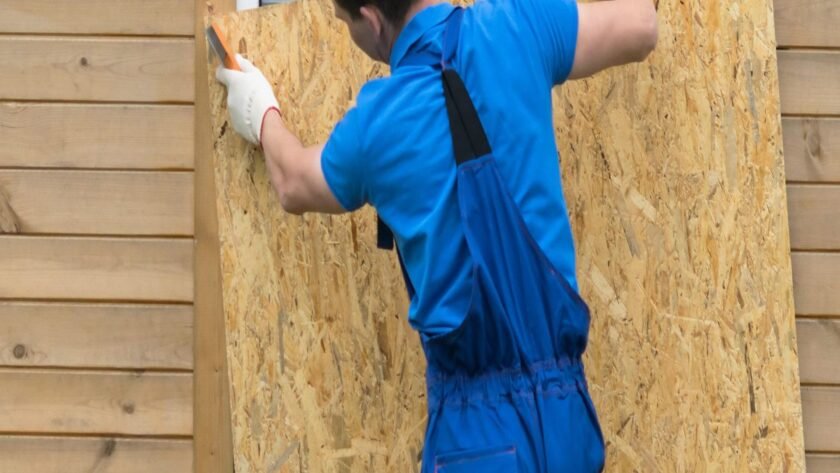When unexpected events like break-ins, severe weather, or accidents damage your property, swift action is crucial to secure your premises. Emergency boarding up services provides an immediate solution to protect your home or business from further harm. This guide outlines the essential steps in emergency boarding up, ensuring you understand the process and can respond quickly.
Assessing the Damage
The first step in emergency boarding up is to assess the extent of the damage. Carefully examine the affected area to determine the best approach, whether a broken window, a damaged door, or another vulnerable area. Assessing the damage helps in planning the boarding up process effectively, ensuring all vulnerable points are covered to prevent unauthorised access and further damage.
Gathering Materials and Tools
Once you’ve assessed the damage, gather the necessary materials and tools for boarding up. Typical materials include plywood boards cut to size, screws or nails, a drill or hammer, and safety gear such as gloves and goggles. Having these items ready beforehand speeds up the boarding up process and ensures you can secure your property promptly. For added assistance or in complex situations, consider using professional boarding up services.
Boarding Up the Area
With materials and tools, proceed to board up the damaged area. Start by placing the plywood boards over the opening, ensuring they fit snugly and cover the exposed area. Use screws or nails to secure the boards firmly in place, making sure they cannot be easily dislodged. Pay attention to corners and edges to prevent gaps that compromise security.
Securing and Finishing
After boarding up the damaged area, reinforce the boards if necessary to enhance stability and durability. Check all screws or nails to ensure they are tightly fastened. Additionally, consider adding extra security measures such as padlocks or additional boards for larger openings. Finally, the boarded-up area from both inside and outside must be inspected to verify its effectiveness in preventing unauthorised entry.
Temporary Weatherproofing
When the damage is due to severe weather conditions such as storms or hurricanes, securing the area and providing temporary weatherproofing is essential. Use waterproof tarps or plastic sheeting over the boarded-up area to prevent water ingress and further damage to the interior of your property. Secure these coverings tightly to ensure they withstand strong winds and heavy rain.
Notifying Authorities and Insurance
After boarding up your property, notify the relevant authorities, such as the police or fire department, if the damage was caused by criminal activity or a fire. Contact your insurance provider to report the incident and the temporary measures taken. Document the damage thoroughly with photos and written descriptions to support your insurance claim. Prompt notification and documentation can expedite the claims process and ensure you receive adequate coverage for repairs.
Planning for Permanent Repairs
While emergency boarding up provides immediate protection, it is essential to plan for permanent repairs as soon as possible. Consult with a reputable contractor or repair service to assess the damage and develop a plan for permanent restoration. Ensure that any repairs comply with building codes and regulations to maintain the safety and integrity of your property.
Removing Debris and Safety Hazards
Once the immediate boarding up and temporary measures are in place, any debris or hazards from the surrounding area will be safely removed. This includes broken glass from the broken window, damaged materials, or any objects that could pose a safety risk. Clearing the area helps prevent accidents and facilitates easier access for repair professionals when they arrive to assess and fix the damage.
Monitoring and Maintenance
After boarding up and initial repairs, monitor the boarded-up area regularly to ensure its effectiveness. Check for signs of tampering or damage and make any necessary adjustments or reinforcements. Depending on the situation, you may need to maintain the temporary boarding up for an extended period. Stay vigilant and proactive to protect your property until permanent repairs can be completed.
Communicating with Neighbors and Tenants
When the damage affects shared or rented properties, communicate with neighbours or tenants about the emergency boarding up measures taken. Inform them about the incident, the steps to secure the property, and any temporary inconveniences they may experience. Clear communication fosters cooperation ensures everyone is informed and feels secure during challenging times.
Considering Additional Security Measures
Depending on the nature of the damage and the location of your property, consider implementing additional security measures alongside emergency boarding up. It may include installing security cameras, motion-sensor lights, or alarm systems to deter further incidents and enhance overall security. Evaluate your property’s vulnerabilities and consult with security professionals for tailored recommendations.
Reassessing and Updating Emergency Preparedness Plans
After experiencing an emergency that requires boarding up services, take the opportunity to reassess and update your emergency preparedness plans. Review the effectiveness of the boarding up process, identify any areas for improvement, and update contact lists for emergency services and repair professionals. Being proactive in updating your preparedness plans enhances your ability to respond swiftly and effectively in future emergencies.
Conclusion
Emergency boarding up is critical in protecting your property from further damage and securing it during vulnerable times. Following this step-by-step guide, you can confidently handle emergencies that require the services. Remember, acting swiftly and efficiently can minimise risks and provide peace of mind until permanent repairs can be made.




